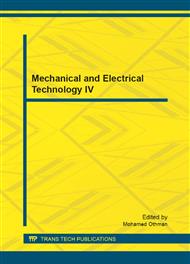p.1507
p.1511
p.1515
p.1519
p.1523
p.1527
p.1531
p.1535
p.1539
Research on FPGA-Based Three-Level Power Amplifier for Active Magnetic Bearings
Abstract:
Three-level power amplifier with the characteristics of a small ripple, Aimed at existing situations of the three-level power amplifier without ASIC chips, a new three-level power amplifier circuit based on FPGA(Field Programmable Gate Array) is presented. Detailed analysis the principle of the three-level power amplifier, According to the principle, the FPGA internal composition and function of each module is designed, programmed using VHDL Language, functional simulated and validated by Modelsim which is specialized simulation software. The actual production of the three-level power amplifier is experimental testing for a step signal and sinusoidal signal. Test results show that the current response of AMB coil is fast and the current track is good. Finally, industrial successful applications in the Active magnetic bearing spindle.
Info:
Periodical:
Pages:
1523-1526
Citation:
Online since:
November 2012
Authors:
Price:
Сopyright:
© 2012 Trans Tech Publications Ltd. All Rights Reserved
Share:
Citation:


